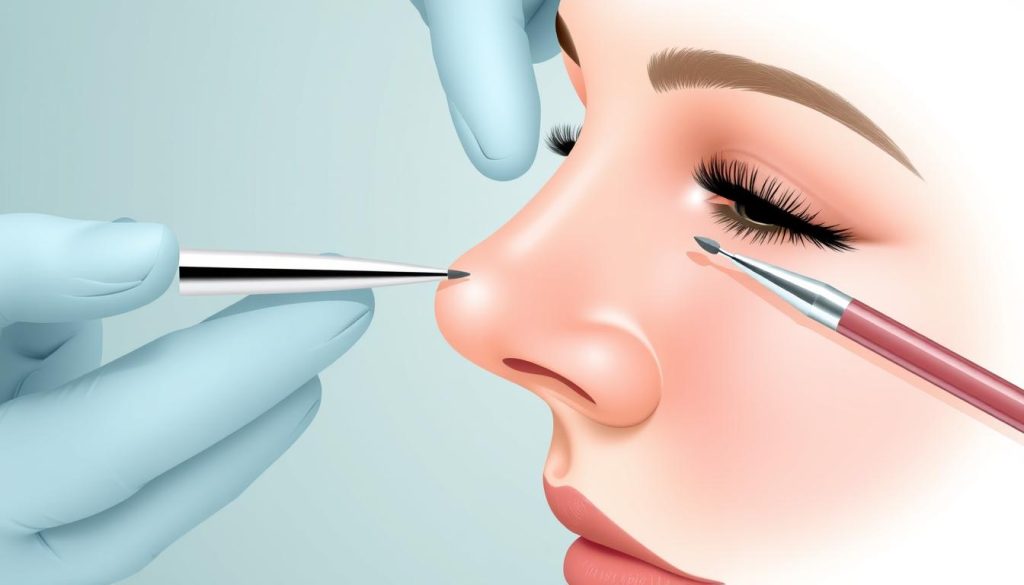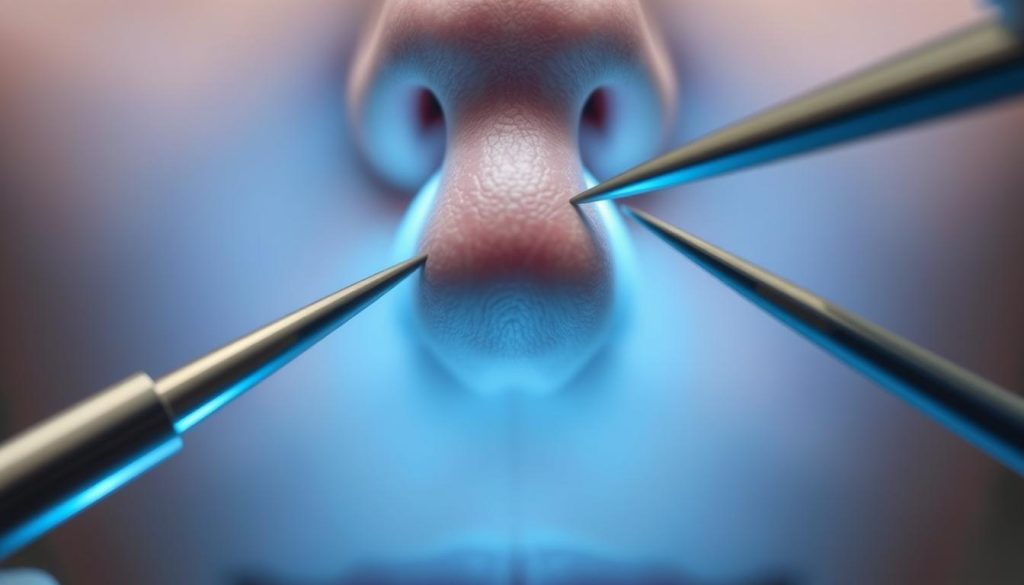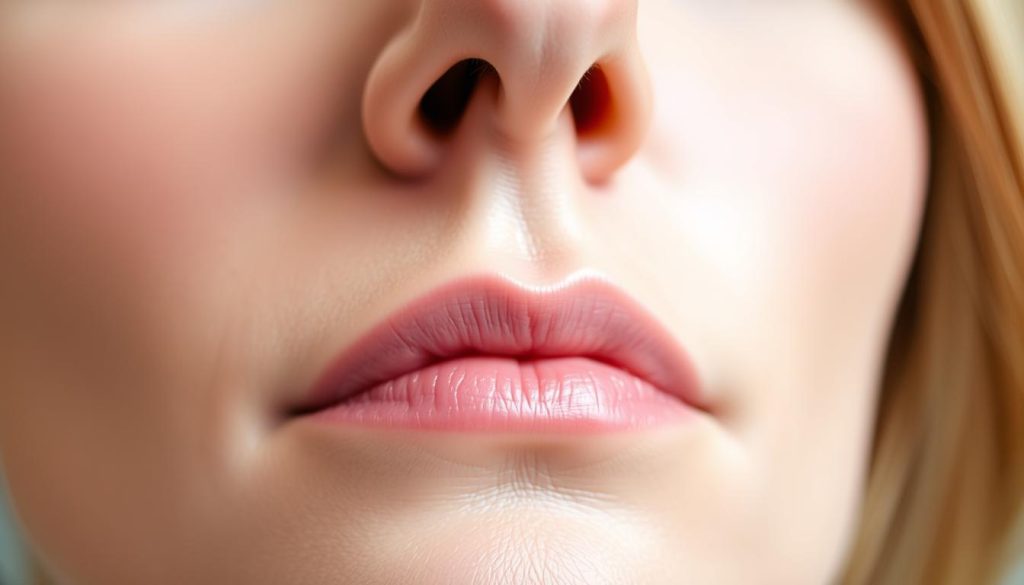Facial aesthetic procedures have become increasingly popular, with rhinoplasty being one of the most sought-after surgeries. Specifically, nasal tip refinement focuses on enhancing the appearance of the nose tip without altering the bony structures.
Nasal tip procedures address various concerns, such as bulbous or droopy nasal tips, wide nostrils, and over-projected tips. By refining the nose tip, patients can achieve a more balanced facial appearance. This specialized rhinoplasty procedure offers a quicker recovery time compared to full surgery, making it an attractive option for those seeking to enhance their nasal aesthetics.
Key Takeaways
- Nasal tip refinement is a specialized rhinoplasty procedure focusing on the nasal tip.
- This procedure addresses concerns like bulbous or droopy nasal tips and wide nostrils.
- Nasal tip refinement offers a quicker recovery time compared to full rhinoplasty.
- Patients can achieve a more balanced facial appearance through this procedure.
- The procedure involves refining the nasal tip without altering the bony structures.
Understanding Nasal Anatomy and Aesthetics
Understanding the intricacies of nasal anatomy is crucial for achieving aesthetically pleasing results in facial aesthetics. The nose is a complex structure made up of bone, cartilage, and soft tissue, all of which contribute to its overall shape and appearance.
The Structure of the Nose
The nose is composed of several key elements, including the nasal tip, the bridge, and the nostrils. The nasal tip is particularly important, as it is a defining feature of the nose’s appearance. The structure of the nose is determined by its underlying anatomy, including the bone and cartilage that provide its framework.
Ideal Nasal Proportions and Harmony
Ideal nasal proportions involve a harmonious relationship between the nose and other facial features, particularly the chin, forehead, and lips. Key aspects of ideal nasal proportions include:
- A nasal tip that is proportional in size and width, creating a gentle transition from the bridge.
- A soft triangular shape when viewed from below, without sharp angles.
- Cultural and individual preferences influencing what is considered “ideal” in nasal aesthetics.
- Facial harmony achieved when the nose complements rather than dominates the face.
By understanding these principles, individuals can better appreciate the complexities of nasal aesthetics and make informed decisions about their own nasal appearance.
Common Concerns with Nose Tip Aesthetics

The nose tip is a crucial aspect of nasal aesthetics, and various concerns can impact its appearance. Individuals seeking rhinoplasty often have specific issues they wish to address to achieve a more harmonious nasal tip.
Bulbous Nasal Tip
A bulbous nasal tip can significantly affect the overall appearance of the nose. This condition is characterized by a rounded or bulbous shape at the tip, which can be due to the structure of the underlying cartilage. Surgical correction involves reshaping the cartilage to achieve a more defined and aesthetically pleasing tip.
Droopy Tip
A droopy nasal tip can give the nose an aged or sad appearance. This concern arises when the tip of the nose hangs lower than the ideal position. Rhinoplasty can address this by adjusting the supporting structures to elevate the tip to a more harmonious position relative to the rest of the nose.
Wide Nostrils and Over-Projected Tips
Wide nostrils and over-projected tips are other common concerns. Wide nostrils can create an imbalance in facial proportions, while an over-projected tip extends too far from the face, potentially disrupting facial harmony. Surgical techniques such as alar base reduction for wide nostrils and precise reduction of the supporting structures for an over-projected tip can help achieve better facial symmetry and harmony.
Addressing these concerns requires a skilled surgeon who can tailor the rhinoplasty procedure to the individual’s specific needs, ensuring that the nasal tip is in harmony with other facial features. By doing so, individuals can achieve a more balanced and aesthetically pleasing appearance.
Types of Nose Tip Procedures

Understanding the types of nose tip procedures is essential for individuals considering rhinoplasty. The choice between different surgical approaches depends on the complexity of the case and the desired outcome.
Tip Rhinoplasty vs. Full Rhinoplasty
Tip rhinoplasty focuses solely on the nasal tip, making it a less invasive procedure compared to full rhinoplasty, which involves comprehensive changes to the nose. Tip rhinoplasty is ideal for individuals who are satisfied with the overall shape and size of their nose but wish to refine the tip.
Open vs. Closed Approaches
The choice between an open and closed approach depends on the degree of invasiveness and the specific adjustments required. An open rhinoplasty provides wide access for significant adjustments to the nasal tip, especially beneficial for complex cases. The closed rhinoplasty technique uses internal nose incisions, preferred to avoid visible scars.
- The open approach involves a small incision across the columella, allowing the surgeon to fully visualize the nasal structures.
- The closed approach utilizes only internal incisions, leaving no visible external scarring but providing more limited visibility.
- Open rhinoplasty is often preferred for complex tip work as it provides better access and visibility for precise cartilage modification.
- Closed rhinoplasty may be suitable for less complex cases and offers advantages such as less post-operative swelling and no visible scarring.
Surgical Techniques for Refining the Nose Tip
Surgical refinement of the nasal tip involves a range of techniques tailored to the individual’s nasal anatomy. The goal is to achieve a more aesthetically pleasing and harmonious nasal tip that complements the overall facial structure.
Suture Reshaping Techniques
Suture reshaping is a technique used to redefine the shape of the nasal tip without removing cartilage. By using sutures, surgeons can reconfigure the existing cartilage to achieve the desired tip shape and projection.
Cephalic Trimming
Cephalic trimming involves the removal of a portion of the lateral cartilage to refine the nasal tip. This technique is often used in conjunction with other methods to achieve optimal results.
Cartilage Grafting Methods
Cartilage grafting is a versatile technique that involves harvesting cartilage from one part of the body and grafting it onto the nasal tip. This can be used to add support, change the shape, or enhance the projection of the tip.
The choice of surgical technique depends on the individual’s nasal anatomy and the desired outcome. Cartilage grafting, for instance, is particularly useful in revision rhinoplasty cases where previous surgeries may have compromised the nasal tip’s structure.
| Technique | Description | Application |
|---|---|---|
| Suture Reshaping | Redefines tip shape without removing cartilage | Primary rhinoplasty |
| Cephalic Trimming | Removes part of lateral cartilage to refine tip | Reducing bulbous tips |
| Cartilage Grafting | Adds support or changes tip shape | Revision rhinoplasty, enhancing tip projection |
By employing these advanced surgical techniques, surgeons can achieve a more refined and aesthetically pleasing nasal tip. The key to successful rhinoplasty lies in the precise application of these methods, tailored to the individual’s unique nasal anatomy.

The Consultation Process
The initial consultation provides a platform for patients to discuss their concerns and goals with a qualified surgeon. This meeting is crucial for determining the best approach for nose tip rhinoplasty.
Finding a Qualified Surgeon
Finding a surgeon who is experienced in rhinoplasty is vital. Patients should look for a surgeon who is board-certified and has a proven track record with nose tip procedures. A skilled surgeon will be able to assess the patient’s nasal anatomy and recommend the most appropriate technique.
What to Expect During Your Initial Consultation
During the consultation, the surgeon will perform a thorough examination of the nose, assessing both its aesthetic and functional aspects. The surgeon may use computer imaging or before-and-after photos of similar cases to help the patient visualize potential outcomes. The discussion will cover the recommended surgical approach, expected results, risks, recovery, and costs associated with the procedure.
A quote from a renowned plastic surgeon highlights the importance of the consultation:
“The consultation is a critical step where we tailor the surgical plan to the patient’s unique needs and expectations.”
| Key Discussion Points | Description |
|---|---|
| Nasal Anatomy Assessment | Evaluation of the nose’s structure to determine the best surgical approach. |
| Expected Outcomes | Discussion of the potential results based on the patient’s anatomy and the chosen technique. |
| Risks and Complications | Explanation of possible risks and how they can be mitigated. |
By the end of the consultation, patients should have a clear understanding of what to expect from their nose tip rhinoplasty surgery. This is also an opportunity for patients to request a consultation and take the first step towards achieving their aesthetic goals.
Preparing for Your Nose Tip Procedure
As patients prepare for their nose tip procedure, understanding the steps involved is crucial for a smooth and successful experience. This preparation not only involves physical readiness but also mental preparation to achieve the desired results and appearance.
Pre-Operative Guidelines
Before the procedure, patients must follow specific pre-operative guidelines to minimize risks and ensure optimal results. These guidelines may include avoiding certain medications, quitting smoking, and arranging for post-operative care. By adhering to these guidelines, patients can significantly reduce the risk of complications.
Setting Realistic Expectations
Setting realistic expectations is crucial for patient satisfaction with nose tip procedures. While significant improvements can be achieved, perfect symmetry and exact shape cannot be guaranteed. The final outcome depends not only on the surgeon’s skill but also on the patient’s healing process and tissue characteristics.
To help visualize potential results, computer imaging can be used. However, this should be understood as an approximation rather than a guarantee. Rhinoplasty patients should be prepared for the emotional aspects of facial change and the temporary swelling and bruising that occur during recovery.
| Pre-Operative Instructions | Purpose |
|---|---|
| Avoid certain medications | Minimize bleeding risks |
| Quit smoking | Enhance healing and reduce complications |
| Arrange post-operative care | Ensure a smooth recovery |
If you’re considering a nose tip procedure, it’s essential to request consultation with a qualified surgeon to discuss your options and what to expect. By doing so, you can make an informed decision and achieve a natural, balanced nasal appearance.

Recovery and Healing Process
Proper recovery and healing are essential for maximizing the outcomes of nasal tip aesthetics. The post-operative period requires careful management to ensure that the nasal tip heals correctly and that the desired aesthetic results are achieved.
Immediate Post-Operative Care
Immediately after the surgery, patients should follow specific guidelines to facilitate healing. Avoiding strenuous activities, bending over, and heavy lifting for at least 2-3 weeks helps prevent increased swelling and bleeding. Patients are also advised against blowing their nose, engaging in strenuous activities, and consuming spicy foods to prevent dislodging the internal nasal structure and aggravating the nasal tissue.
Week-by-Week Recovery Timeline
The recovery process varies among individuals, but generally follows a predictable timeline. Sleeping with the head elevated helps reduce swelling and promotes better drainage. Most patients can return to their normal activities within a few weeks, although swelling and bruising may take longer to resolve.
Tips for Optimal Healing
To support the healing process, maintaining a healthy diet rich in vitamins and proteins is recommended. Protecting the nose from sun exposure is also crucial, as the healing skin is more susceptible to sunburn and hyperpigmentation. Following all surgeon-recommended restrictions regarding glasses, contact sports, and nose blowing is essential for optimal healing.
- Avoiding strenuous activities and heavy lifting for 2-3 weeks
- Protecting the nose from sun exposure
- Maintaining a healthy diet
- Sleeping with the head elevated
- Following surgeon-recommended restrictions
Achieving Natural-Looking Results
Ensuring a natural-looking result after nose tip rhinoplasty involves a deep understanding of facial aesthetics and the ability to create subtle refinements that enhance one’s overall appearance. A skilled rhinoplasty surgeon can make a significant difference in achieving a nasal tip that harmonizes with the rest of the facial features.
The most successful nose tip procedures result in improvements that appear natural, as if the patient was born with that nose shape. Preserving the nasal valve during surgery is crucial for maintaining normal breathing and ensuring the longevity of the results. With years of experience, surgeons can deliver results that not only meet but exceed patient expectations, providing a refined nasal tip that ages naturally with the rest of the face.
FAQ
What is the difference between tip rhinoplasty and full rhinoplasty?
Tip rhinoplasty focuses on refining the nasal nasal tip cartilage to improve its shape and appearance, whereas full rhinoplasty involves modifying the entire nose, including the bridge and nostrils, to achieve a more comprehensive aesthetic transformation.
How long does it take to recover from a nasal tip rhinoplasty procedure?
The healing process typically takes several weeks, with most patients experiencing significant improvement within 1-2 weeks, although it may take several months for the final results to become apparent.
What are the benefits of suture reshaping techniques in rhinoplasty surgery?
Suture reshaping techniques allow for a more precise and controlled modification of the nasal tip, enabling surgeons to achieve a more refined and natural-looking appearance without the need for excessive tissue removal or grafting.
Can rhinoplasty improve nasal breathing?
Yes, rhinoplasty can improve nasal breathing by correcting deviations or obstructions in the nasal valve or other areas of the nasal passage, thereby enhancing respiratory function.
What is the difference between open and closed rhinoplasty approaches?
The open approach involves making an incision between the nostrils to provide greater visibility and access to the nasal structures, whereas the closed approach involves making incisions within the nostrils, resulting in less visible scarring.
How can I ensure optimal healing after rhinoplasty?
To promote optimal healing, patients should follow their surgeon’s instructions carefully, avoid strenuous activities, and attend follow-up appointments as scheduled.
What are the risks associated with revision rhinoplasty?
Revision rhinoplasty carries similar risks to primary rhinoplasty, including infection, scarring, and asymmetry, although the complexity of the procedure may be greater due to the presence of scar tissue and altered nasal anatomy.
Can I undergo rhinoplasty if I have a bulbous nasal shape?
Yes, rhinoplasty can be performed to refine a bulbous nasal shape, although the specific techniques used will depend on the individual’s nasal anatomy and aesthetic goals.
